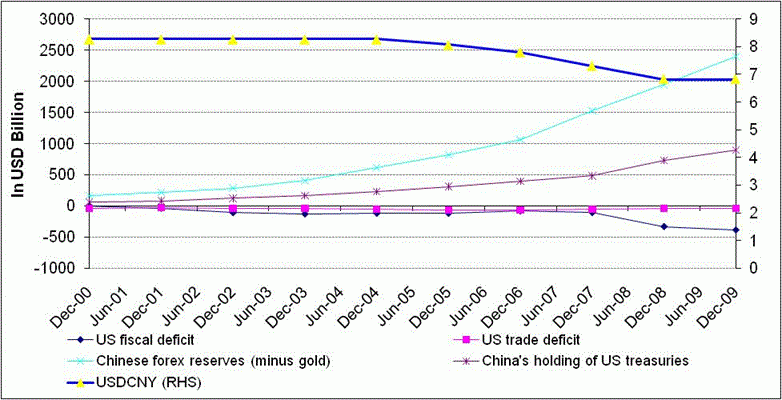The First World War (1914-1918) was the result of a complex intertwining of several politico-economic factors. But what finally triggered it into a full-blown war was the assassination of Archduke Franz Ferdinand of Austria when he had gone on a visit to Sarajevo in June 1914. The current spate of competitive currency devaluations across both the developed and developing worlds, remarkably titled a “currency war” by the Brazilian finance minister, is hopefully not another world war in a new avatar. Yet, like World War I, this war too seems to be the culmination of several factors, but triggered by one (Bergsten 2010, Huang 2010). What could that one trigger be?
If the actions, secrecy, and scale of growth in China are causing macroeconomic imbalances – such as trade deficits – in others, this suggests that the trigger could be China’s policies. The Asian giant’s thrust on export-led growth in the last two decades, on the back of a managed currency, has paid rich dividends to its economy with unprecedented growth rates. These in turn have translated into accumulation of a huge amount of foreign-exchange reserves for the Chinese central bank. Yet this accumulation has spawned multiple effects, not only on the Chinese economy but also in the international arena – not least of which are commodities and foreign-exchange markets.
China – The story of growth begets growth…
The Chinese growth story has proved, more than anything else, that growth begets growth. Its strategy of leveraging its pool of low-cost labour to spur manufacturing, while creating capacities and infrastructure for achieving this, has made it one of the biggest users, importers and investors of most commodities. When imports of strategic commodities at market-driven prices appeared fickle, it went ahead and captured supplies at their origin. This lethal combination of access to cheap raw materials, labour and currency managed to keep Chinese exports competitive on a sustainable basis. This has not only put a prolonged pressure on global commodity prices but also caused a spillover on to the currency market. Other emerging nations, which by that time started floating their currencies and opening up their industries linking their economies to the global economy, began to feel the heat of the Chinese policy, which badly hurt their currencies and competitiveness.
On its part, China has not been keeping its trade surplus idle but has been using it to bridge the income-consumption gap of its importing countries, increasingly by investing in the US Treasury – a strategy similar to that adopted by businesses that provide their employees with incentives to buy products of their clients.
The three pronged effect of China’s trade surplus…
- Increasing Chinese demand for US Treasury papers continues to keep the cost of US borrowing low. Interest rates in the US, in turn, do not reflect the American long-term ability, or the lack of it, to keep up with increasing consumption.
- Purchases by China of other debts such as those of Japan, Malaysia, and South Korea using the surplus dollars has clogged the currency markets and, thus, has resulted in the appreciation of their currencies, which has led to a quiet (South Korea) or visible (Malaysia and Japan) attempts at market intervention of the respective countries to check such currency appreciation.
- China’s direct sourcing of major commodities from the centres of production “blinded” the global commodity markets of their fundamentals, though its commodity sourcing related activities were reflected in the currency markets due to the transactions involved.
The Chinese have been able to withstand the resultant pressures on the renminbi, thanks to its huge export surplus, managed currency, a $2 trillion-plus pile of foreign exchange reserves, and its hostility in international relations. But not all nations have the wherewithal to be another China. Thus, surging commodity prices led to appreciation of commodity currencies such as the Brazilian real and the Canadian dollar, both of which strengthened about 8% against the dollar in the past year (July 2009-June 2010) on the back of a surge in the prices of commodities of which these countries are the major exporters. Not the renminbi, which, after huge international pressure on China, was allowed to appreciate in a very gradual manner. An agreeable outcome from this is the Chinese currency standing like the Rock of Gibraltar against the dollar. Yet all possible economic fundamentals – from the US trade deficit to China’s accumulation of US Treasuries – suggest a natural appreciation of the currency, as shown in Figure 1.
Figure 1. The China-US tango
While it is true that currency markets react to a number of factors, and exchange rates are the outcome of interplay of all these factors, the role of China in international trade, especially of commodities and thus in currency markets, cannot be overemphasised. What is alarming is the apparent equilibrium that China’s policies are leading the world economy to, at least in the medium term.
The trillions of dollars of foreign-exchange reserves accumulated by China have been used by the Chinese monetary authorities for decades to invest in US Treasury papers, which went on to finance the ever-yawning trade deficit in the US. The role of cheap Chinese exports in feeding the never-satisfied American consumer, which nearly brought the most powerful nation to its brink, is well understood. What many China-bashers in the US forgot to notice however is that the massive Chinese investments in US Treasury bonds also helped keep US interest rates low. The low interest-rate regime of the Greenspan era can be directly attributed to such policies emanating from the Chinese soil, which also provided a boost to investment and employment growth until 2007/2008. Conveniently, for exactly the opposite reasons, the US Federal Reserve is compelled to keep interest rates low in the period following the Great Recession for pump priming its sagging economy. With the Chinese continuing to mop up the Treasuries, it is in fact aiding the Fed to keep interest rates low. However now, with near-zero interest rates and little profitable investment avenues visible to US businesses, capital is flying off to regions where returns appear more promising, notably to the emerging economies in Asia. The result is an appreciation of the local currency as is the case witnessed in many countries now.
Supporting players in the currency game…
To be sure, there are other “supporting players” in this ongoing currency game. For instance, the great surge in exports of electronic items and automobiles by South Korea is being perceived by its Japanese competitors more as an outcome of a cheaper won relative the yen than an outcome of productivity improvements in Korean industries. Hence, Tokyo is making a lot of noise against Korean interventions aimed at depressing the won. Similarly, the rally in the Brazilian real by almost 30% in the last 18 months led its finance minister to make the caustic comment mentioned in the opening paragraph. Although it is believed that availability of dollar-denominated bonds in Brazil has made the country a favoured destination for foreign capital, a wary government has resorted to strong measures to discourage capital flows.
These “actors” were possibly catalytic agents in the evolving global scenario of competitive currencies. The situation has developed with the dollar still being the most stable currency, in spite of the continuing economic woes of the US. Holding US Treasuries with sovereign capital is still the safest bet and the most popular investment avenue for central banks. But the size of sovereign investible surplus of most countries is much smaller than that of the Chinese, which, together with its historical penchant for US Treasuries, translates into interest-rate effects in the US and from there to international currency markets. Thus, in July 2010, mainland China held about 21% of aggregate US Treasury securities, slightly lower than the 27% it held in July 2009. The effect of size was clearly visible when the Chinese invested about $25.5 billion in Japanese bonds in the first seven months of 2010, resulting in the yen reaching its 15-year high (against the dollar), which probably triggered the recent “currency war”.
This instance possibly also brought to light another peculiar outcome of the “dollarisation” of the renminbi. As and when China sells dollars to invest in sovereign bonds, it depresses the greenback and appreciates its own currency. This by itself limits its ability to diversify out of dollars or dollar-denominated papers. At the same time, the Chinese central bank has deliberately followed an ultra-loose monetary policy in order to keep the renminbi cheap – requiring increasingly larger market interventions in the face of its growing current-account surplus. The impact on asset and, of late, food price inflation was a logical outcome, which the government is trying to address only now.
A tango and inseparable two…
The current spate of emerging market currency appreciation may appear to be another chapter in the “trade wars” between the US and China. It may appear that an undervalued renminbi enables the flooding of US markets with cheap Chinese goods, while a frustrated US battles hard to kick-start its domestic economy. But as our discussion above shows, China’s huge trade surplus has facilitated its continued investment in the US and enabled the continuation of a low interest rate regime that the latter wanted to maintain in its effort to steer the economy out of the woods. A low interest rate regime in the US led to most of its investors chasing the emerging market returns, thereby pressurising currency fundamentals. Though these two economies may be putting on public posture against each other, they are quietly playing a tango that neither can step out of. The same messy equilibrium contributed to the Great Depression and is now causing the current consternation in world currency markets. But it is an equilibrium, nonetheless.
References
Bergsten, Fred (2010), “China’s currency and the US economy”, VoxEU.org, 1 November.
Huang, Yiping (2010), “A currency war the US cannot win”, VoxEU.org, 19 October.


